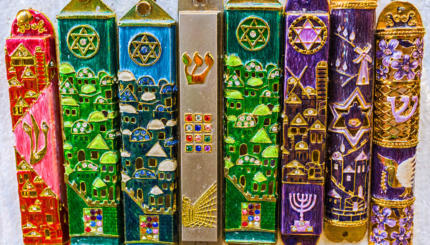December is here along with the season of Christmas lights, cookies, Festivus celebrations, holiday shopping, the Elf on the Shelf, and now… the Mensch on a Bench.
For the last couple of years, I’ve admired the creativity of several of my Facebook friends who have posted photos of their Elves on the Shelf staged quite mischievously each night leading up to Christmas. It seemed Jewish families just didn’t have a good option available for such a doll in their house. And then, last year, I stumbled on the Kickstarter campaign for the Mensch on a Bench and was very impressed to see a Jewish version of this toy.
The Mensch, named , is a one-foot tall plush doll. To my eye, he looks stereotypically Jewish: he’s got a beard, a black hat, and a scarf resembling a (prayer shawl). He’s got a Hebrew name (Moshe) and could have jumped off the screen of Fiddler on the Roof. When I see the Mensch, he looks nothing like most Jews I know.
Most Jews I know never wear a tallit. Most Jews I know never wear a black hat. And, most Jews I know don’t have beards. Only some of the Jews I know are men. And only some are white.
I understand that the Mensch’s creator had to choose one “look” for the Mensch, and so it’s impossible for him to represent us all. Admittedly, I’m not sure what the Mensch should look like. But I can’t help but wonder if this Mensch is inadvertently perpetuating some stereotypes – conveying that this is what “authentic” Jews look like.
If the Mensch looked more like the Elf but was wearing blue and white, I’d be happier. Or, if there were different versions of the Mensch showing the diversity of the Jewish community, I’d be way happier (and I’d probably buy them all!).
Also problematic is the book that accompanies Moshe the Mensch. That story opens with an illustration of a family lighting a Hanukkah menorah. You guessed it: a white family with a mom and a dad and a son and a daughter. A family in which the dad and son wear yalmulkes as head covering. While some families I know look this, others do not. Some have two dads, some have only a mom, some have a child or parent of a different race, some have no children. And while some Jewish men (and women!) wear yarmulkes, most do not. When we designed coloring book pages at OurJewishCommunity.org for Hanukkah, we purposefully included images that reflected diversity: interfaith families, Jews without yarmulkes, kids in wheelchairs, same-sex parents, etc.
Sadly, I think the images reflected in this opening illustration of the Mensch book present the most traditional approach, one that simply doesn’t reflect the identity of most Jews today. While Moshe may be typical of how Jews are most often portrayed, I think it misses an opportunity to more accurately reflect the diversity of the Jewish community.
A few months ago, I had an opportunity to meet with the Mensch’s creator (and he was nice enough to give me a Mensch!). A former Hasbro employee, now a dad and an entrepreneur, Neal Hoffman is an impressive guy.
Overall, I like the Mensch and think it’s nice that there is a Jewish version of the Elf. Also great is that the the Mensch encourages mensch-like qualities. He comes with a set of Hanukkah rules, one of which is to choose a night of Hanukkah to give gifts to people in need.
It turns out I’m not the only one evaluating the Mensch this week. The Mensch on the Bench will be on Shark Tank this Friday night, so we’ll see what the sharks think. In the meantime, I’d love to hear your thoughts about the Mensch’s looks; please share your comments here.
The Jewish world is full of debates. Get the latest in MyJewishLearning’s weekly blogs newsletter.


